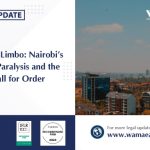The Black’s Law Dictionary[1] defines “Intellectual Property” as a category of intangible rights protecting commercially valuable products of the human intellect and they include trademarks, patents, copyrights, trade secrets, publicity rights, moral rights and rights against unfair competition.
Intellectual Property rights are private rights that are negative rather than positive and whose essential characteristic is to exclude third parties from using and/or exploiting the subject matter of Intellectual Property belonging to another. In Kenya, Intellectual Property rights are conferred either by statute or common law and they include;
- Patents under the Industrial Property Act
- Copyright and related Rights under the Copyright Act
- Trademarks under the Trade Marks Act
- Industrial Designs under the Industrial Property Act
- Utility models under the Industrial Property Act
- Technovations under the Industrial Property Act
- Geographical indications under the Trade Marks Act and soon to be Geographical indications Act (still a bill)
- Trade secrets by common law
- Plant Breeders Rights under the Seeds and plant Varieties Act
- Traditional knowledge under the Constitution[2]
The Movable Property Security Rights Act, 2017 (hereinafter “MPSRA”) provides for registration of security rights in movable properties. The MPSRA defines Acquisition Security Rights [3] to mean a security right in a tangible asset or intellectual property which secures the obligation to pay any unpaid portion of the purchase price of the asset or other credit extended to enable the grantor to acquire it to the extent is used for that purpose. The said Act defines Intellectual Property to mean:
- Copyright as defined in section 2(1) of the Copyright Act, 2001;
- Industrial Property as defined in section 2(1) of the Industrial Property Act, 2001;
- Trademark as defined in section 2(1) of the trademarks Act; and
- Any other related right.
Further, section 878 (4) (i) of the Companies Act, 2015 (hereinafter the “Companies Act”) implies that a company may create a charge over the company’s good will or intellectual property. Section 878 (7) of the Companies Act defines Intellectual Property to mean:
- Any patent, trade mark, registered design, copyright or design right; or
- Any licence under or in respect of any such right.
SECURITY RIGHTS OVER INTELLECTUAL PROPERTY RIGHTS – CONCERN FOR LENDERS
Financial institutions and investors still prefer to use immovable, tangible properties as collateral as opposed to IPRs. However, companies with high net worth of IPR’s have successfully influenced the credit sector of financial institutions which have now shown willingness to hold certificates of grant of Patents, Trademarks, and Industrial Designs e.t.c as security for loan facilities through debentures and floating charges. This has greatly shifted over-reliance on traditional securities and enabled greater economic growth for individual firms and the national economy.
BACKGROUND OF MPSRA
The objects and reasons for enactment of the MPSRA are as follows:
- Provide for use of credit facilities as collateral;
- Establish the office of the Registrar of Security Rights;
- Promote consistency and certainty in secured financing relating to movable assets;
- Enhance the ability of individuals and entities to access credit using movable assets; and
- To establish a Registry to facilitate the registration of notices relating to security rights in movable assets.
MPSRA defines movable assets to mean any tangible asset (i.e. all types of goods including motor vehicles, crops, machineries, livestock) or intangible asset. Examples of intangible assets are, receivables (amounts which are owed to a business and regarded as assets), choses in action (for example right to sue for damages for an injury, rights of a beneficiary to an estate of a deceased and rights of an employee to unpaid wages), deposit accounts, electronic securities (securities not represented by a certificate) and intellectual property rights.
Section 14 of the MPSRA provides that a security right in a tangible asset with respect to which intellectual property is used does not extend to the intellectual property and a security right in the intellectual property does not extend to the tangible assets.
Securitization of IPR differs from securitization of other kinds of traditional assets due to the unique nature of IPRs. IPRs are distinct from the rights to payment that flow from it such as payment of royalties.
- IP rights are exclusive rights which are enforceable against anyone. However, there are limitations that exist such as fair use in case of copyrights. Patent protection is also subject to exceptions such as the “Research Exemption”;
- IP rights cannot be held in possession i.e. they are purely intangible which may be enjoyed by an indefinite number of people simultaneously.
- IP rights are referred to as Public Good meaning that they are both non-rivalrous (many people can benefit from information without interfering in the pleasure others receive from the same information) and non-excludable (once information is disclosed, it is difficult to exclude others from using the same information); and
- IP is mostly contained in a tangible asset. In these physical embodiments there are in reality two sets of property rights i.e. those in the tangible item and those embodied in the intellectual property.
Based on the unique characteristics of the IP, the secured transaction relating to IP can be divided into 2 categories: IP rights transaction and financing transaction. IP rights transaction consist of transactions in which the IPRs themselves serve as security of the borrower including rights in patents, trademarks or copyrights; financing transactions involve IP on other movable assets including equipment, inventory or receivables
A financing transaction is a non-recourse debt financing, where a licensor of intellectual property can take the future cash flow expected from a license agreement and receive a cash payment up front, representing the present value of the future cash flow. Intellectual property royalty financing allows the owner of the intellectual property to keep an equity interest in the intellectual property, and thus, the owner of such property can still profit from the upside value of such an asset beyond the security interest on the debt.
CHALLENGES OF INTELLECTUAL PROPERTY SECURITIZATION
The use of IP as a collateral is an emerging business option that offers financing opportunity for companies with valuable IP assets seeking alternative sources of capital.
As much as there are many benefits of using intellectual property as security the same comes with its own challenges as discussed here below:-
- Whereas other forms of security are tangibles, intellectual property are purely intangibles. It is because of the intangible nature of intellectual property that financiers are more often than not unwilling to offer financing based on the IP assets.
- Valuation is a key tool in the process of financing based on IP assets. Technical valuations are required of intangible assets to give a point in time value of the IP for the purpose of securitization. IP securitization presents significant difficulties due to valuation issues regarding the intangible nature of IP assets. Generally, the real value of particular IP assets cannot be measured accurately because of the nature of IP assets as intangible.
- Awareness of IP value is lacking. Most creative industries remain dependent on intangible assets and conventional financing transactions.
- The infringement risk poses a challenge and affects the unpredictability of IP and royalty cash flow. Any unpredictability of royalty income due to such infringements may diminish the attractiveness of the future royalty and cash flow receivables based on securitization.
- Although the MPSRA recognizes the use of Intellectual Property as collateral security, there is no specific law or regulation with regards to perfection, priority and enforcement of IP securitization. The uncertainty of the law may raise doubts in determining whether an Intellectual Property Security is worthwhile for the banking industry.
- While the ownership of IP is asserted through IPR, the enforcement of those rights may still be expensive and time-consuming; this is due to the fact that IP and other intangible assets are often embedded within the firm that developed them, separating them from the firm may not be easy or straightforward. This makes the ability of lenders to exercise claims on those assets potentially difficult.
- There is no established liquid market for intellectual property. This makes it a challenge for lenders to discover a market price and also the disposal of the asset. It is therefore a risk for Financiers to take IP as collateral as IP has no immediate liquid cash value.
- In Kenya, there are various laws and regulations governing various intellectual property i.e. Trademarks Act, Copyright Act, Industrial Property Act. The lack of a common and unified law regulating Intellectual Property possess as a risk as there are no definite laws on securitization and enforcement of intellectual property. Further trademarks and patents registered only in Kenya are not enforceable in both regional and international levels unless also registered under the various international regimes such as ARIPO[4] and WIPO[5].
Section 81 (1) of the MPSRA which provides that the Law applicable to the creation, effectiveness against third party and priority of a security right in an intangible assets is the law in which the grantor is located is in conflict with section 81 (4) of the MPSRA which provides that the law applicable to the creation, effectiveness against third parties and priority of a security right in Intellectual Property is the Law of the country in which the intellectual property is protected. The grantor of security rights over any intellectual property could be domiciled in a country different from where the intellectual property in question is registered. Any conflict in laws of the two countries can make the realization process difficult.
CONCLUSION
Financiers should not shun granting securities over IP rights. However, they need to be careful while offering intellectual property-based collateral and should ensure that any IP is registered under the relevant municipal and international organizations such as ARIPO and WIPO to serve as a better security.
[1] 10th Edition, 2014
[2] http://kenyalaw.org/kl/index.php?id=1899
[3] Section 2
[4] Africa Regional Intellectual Property Organization
[5] World Intellectual Property Institution












